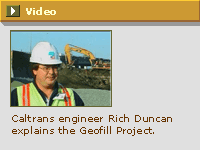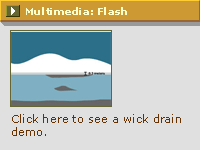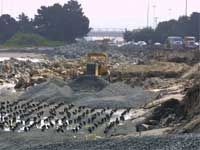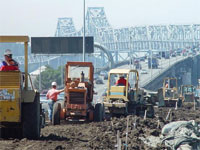|
 The builders of the new East Span's west bound landing area on the Oakland shore confronted unique challenges presented by the site's proximity to the bay and its effect on soils. The builders of the new East Span's west bound landing area on the Oakland shore confronted unique challenges presented by the site's proximity to the bay and its effect on soils.
Not only did engineers and construction crews have to build and stabilize a new roadbed out along the Bay shore next to speeding traffic, they also had to make sure the soil beneath the new road copes with road-buckling water seepage and avoids liquefaction during an earthquake.
To learn more, visit
The Geofill Project Photo Gallery
Called the Geofill project, the job required the placing of 72,000 cubic yards of fill and 22,000 cubic yards of rock to make a roadway where only water and mud stood before.
 The work also includes the installation of fields of plastic wicks and flexible plastic drain pipes that act as a sump system, allowing water driven into the road substrata by earthquake motions to dissipate through a gravel layer rather than remain on the site and compromise the integrity of the roadbed. The work also includes the installation of fields of plastic wicks and flexible plastic drain pipes that act as a sump system, allowing water driven into the road substrata by earthquake motions to dissipate through a gravel layer rather than remain on the site and compromise the integrity of the roadbed.
One section at a time, the 6,000 plastic, fabric-covered wicks, driven as far as 75 feet into the underlying mud, and the 17,000 4-inch pipes with special anchor plates were driven into the bottom of roadbed by specially fitted pile driving cranes. On top of this were placed gravel layers, then fill.
 In the construction phase, these pipes and wicks also play a role in stabilizing the area. In order to consolidate and "densify" the new roadbed, crews added a "surcharge" layer of soil so heavy it actually presses water out of the roadbed via the wicks and drains, much like pressing a wet sponge with your hand. As the water and air are removed from the soil, the entire site begins to settle. Caltrans expects settlement to take nine months. In the construction phase, these pipes and wicks also play a role in stabilizing the area. In order to consolidate and "densify" the new roadbed, crews added a "surcharge" layer of soil so heavy it actually presses water out of the roadbed via the wicks and drains, much like pressing a wet sponge with your hand. As the water and air are removed from the soil, the entire site begins to settle. Caltrans expects settlement to take nine months.
 After the ground has been adequately compacted, the area will be ready to support the new westbound approach and a relocated maintenance road. The surcharge layer will be removed and replaced in part by the lighter layer of cellular concrete. Crews also installed data sensors in the roadbed to measure water pressure and provide other settlement information. After the ground has been adequately compacted, the area will be ready to support the new westbound approach and a relocated maintenance road. The surcharge layer will be removed and replaced in part by the lighter layer of cellular concrete. Crews also installed data sensors in the roadbed to measure water pressure and provide other settlement information.
Prime contractor: Gordon N. Ball Inc.
Subcontractors: Nilex Corp.
|

